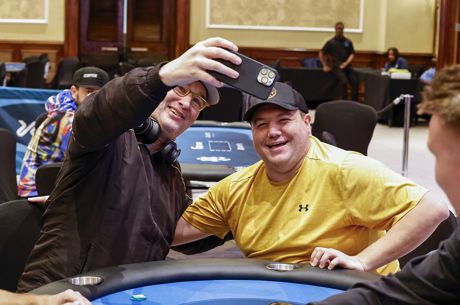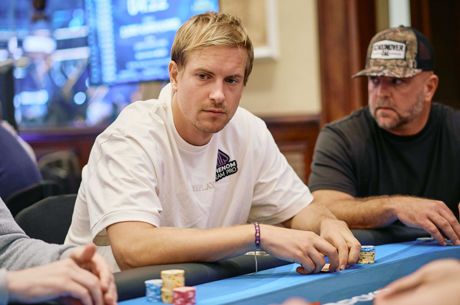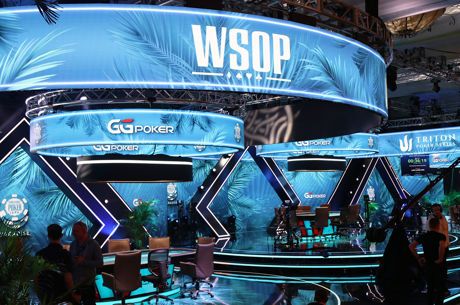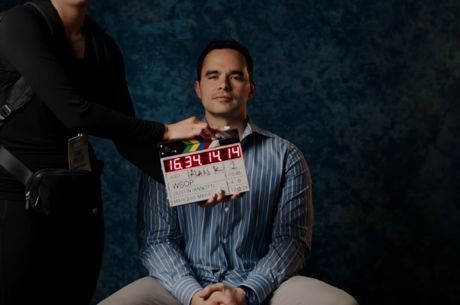Simulating The November Nine Part 2: Who Will Win the Key Hands?

With the 2016 World Series of Poker Main Event final table just weeks away, PokerNews and Advanced Poker Training got together to run a series of simulations.
Using the information we had gathered to create November Nine bios, we devised a basic playing style for each player. Advanced Poker Training, which offers poker training (not in the usual video tutorial format) by allowing players to play in simulated games against artificial intelligence bots, then took the bios and created bots for each of the November Nine, setting them up to play in a simulation against themselves.
Two Floridian academics, software developers and brothers named Steve Blay and Allen Blay, who founded APT, claim the company's AI bots are designed to play like real humans. While they are by no means perfect clones, they created these bots to emulate the style of play of each of the 2016 November Nine by mapping the information about each player to the 42 configurable traits available for their AI bots.
Predictions were made about the number of wins each player would have based on the stack sizes as a percentage of the total chips in play and the average number of dollars won, using the Independent Chip Model (ICM). A total of 100 simulations were run.
More on the the results, the player bios and the entire process can be found in Part 1 of the series.
Since the winner of the Main Event is considered the game's world champion, the initial statistical analysis looked closely at who won each of the simulations. As the chip leader and most experienced player in the group, Cliff Josephy was considered the favorite. However, the Josephy bot only managed to win 17 out of 100 simulations.
In the end though, his overall earnings were just seven percent off of the predictions, suggesting that even though the Josephy bot did not win as many times as expected, it did manage to finish strong most of the time, something that would be expected from such an experienced player.
Somewhat surprisingly, the bot designed to play like professional gambler Qui Nguyen won 26 out of 100 times, marking the most wins by any player. The Nguyen bot was designed to play the gambler, which paid off with an increased number of wins in this sample size, but also shined through in the fact the bot's overall earnings were only up by just nine percent overall. This meant the bot lived by the sword and died by the sword as well, gambling his way out early often enough to drive overall earnings down.
The final statistical outlier found in the simulations was the fact the bot representing 888poker qualifier and short stack Fernando Pons managed to win five times, even though it was predicted to only win twice. This bot also won 19 percent more prize money than was expected, leading the group.
Since it came in as a qualifier, this bot also came in with no fear of busting ninth and apparently that paid off, as he got lucky early and often enough times to defy the odds in this sample size.
Like any tournament, there were some key hands at the final table in each of the simulations that led to different outcomes. Below we examine seven hands in seven different simulations that led to either Cliff Josephy's downfall, Qui Nguyen's increased number of victories or Fernando Pons' unlikely rise to glory. Click on any of the photos to see a full replay of each hand.
1. The Bigger The Stack, The Harder They Fall

The Cliff Josephy bot got stacked by the Gordon Vayo bot here in a bit of a cooler.
As designed, Vayo had been playing aggressively preflop. In this hand, Josephy decided to match that aggression with some aggression of his own. Unfortunately for Josephy, Vayo had it this time.
In retrospect, if Josephy just called the four-bet instead of shoving with big slick, he may have been able to get away from the hand and eventually find a way to recover.
Holding a huge stack after this hand, the Vayo bot went on to win this particular sim. It was one of 15 wins out of 100 sims for the bot - Exactly the same number it was predicted to win based on its chip stack.
2. Big Slicks Chop The Big Stack

It’s pretty obvious the Josephy bot went too far with the A♣Q♥ here. The three-bet from the Vayo bot was not unexpected, as the bot had been extremely aggressive preflop in this sim.
However, when the Griffin Benger bot four-bet preflop, alarm bells should have been going off.
Instead of the always-dangerous ace-queen hitting the muck, it cost the Josephy bot over 50 million in chips in this particular hand.
Needless to say, the bot did not go on to win this sim. Programmed to be aggressive and use the start-of-play chip lead to its advantage, the Josephy bot appeared to play a little too aggressively in this sim, ultimately leading to its early downfall.
3. We See Your Trap, You Can Never Escape Your Fate

Designed to gamble and play with some aggression, the Qui Nguyen bot switched gears here and limped a massive hand.
When the bot unveiled its trap on the flop, its aggressive image may have got it called in two spots, with both the Kenny Hallaert and Vojtech Ruzicka bots matching its raise.
The Hallaert bot managed to get away from whatever it was holding on fourth street, but when the Nguyen bot turned a set of aces, it still managed to get paid off by a Ruzicka bot willing to risk it all with a flush draw.
Either the Ruzicka bot read Nguyen as having air and wanted to be a hero or it simply made a big mistake here, a definite possibility considering the bot was designed to be among the most intimidated by the weight of the moment.
4. The Qui To This Nguyen

The Benger bot was given all the skills to succeed in these simulations, but appeared to run into a number of very tough spots. This is certainly one of them.
It's hard to put an aggressive gambler on a big hand, even when that opponent five-bets from the small blind. In this sim, the Nguyen bot had already ramped up the aggression and moved into the chip lead when the Benger bot picked up big slick on the button in an unopened pot.
The Benger bot may not have been inclined to six-bet the whole stack against any other opponent, but did so this time.
Cooling off Benger here left the Nguyen bot with a big stack and it went on to run away with this particular sim. The bot's aggressive image was the key to the win, getting it paid off when it had the goods and allowing it to roll on to victory.
5. Better To Be Lucky Than Good

The Jerry Wong bot picks up the kind of hand it can't really fold to: a three-bet from the most aggressive player on the table at the time. And so it does not.
However, the Nguyen bot really gets paid off this time because it takes its foot off the gas for a moment and displays a very nuanced check on the flop.
Perhaps the Nguyen bot was extremely lucky that its opponent turned top pair, but the slick flop check might have helped get more money out of the Wong bot even with a blank on the turn, considering the likelihood the Wong bot might have decided to turn A♣Q♠ into a bluff.
Once again, the Nguyen bot has the goods and finds a way to get paid off. It may have run good in many of the sims, but in this instance, it appears to have played good as well.
6. Let It Ride

The Fernando Pons bot enjoyed a level of success well beyond expectations in the 100 sims, mostly due to its willingness to fail.
As a qualifier who would have to consider making the final table a win in and of itself, the bot was designed to play without a fear of coming in ninth, and did exactly that, moving all in during the first orbit of the overwhelming majority of the sims.
Often that turned out badly, but occasionally, the bot got extremely lucky and found a triple-up to leap into contention.
That's exactly what happened here when the Pons bot ran the A♠J♠ into the Vayo bot's kings and Benger bot's aces, finding a way out of what looked like a terrible and unavoidable mess.
7. No Fear

Sometimes when you have less than 10 big blinds and you're under the gun plus one, you shove five high. Even more so when it's suited.
That's exactly what the Pons bot does in this spot, displaying its lack of fear of finishing ninth by picking two cards and going with them.
It was a little ambitious to think it would get this raise through, but the bot had no idea it would run into the Vayo bot's big slick or the almost-as-short-stacked Wong bot's queens.
The Pons bot sure did pick a good time to flop an open-ender and turn his two opponents dead, making a straight, getting the early triple-up and all the fuel it would need to go on to win this particular sim.
Next week, in Part 3 of this series, we will unveil Advanced Poker Training's strategic analysis of the performance of the bots in the simulations, showing the keys to victory and outlining pitfalls each might have avoided for increased success.
A week later, leading up to the live 2016 WSOP Main Event final table, we will recap the entire series.










